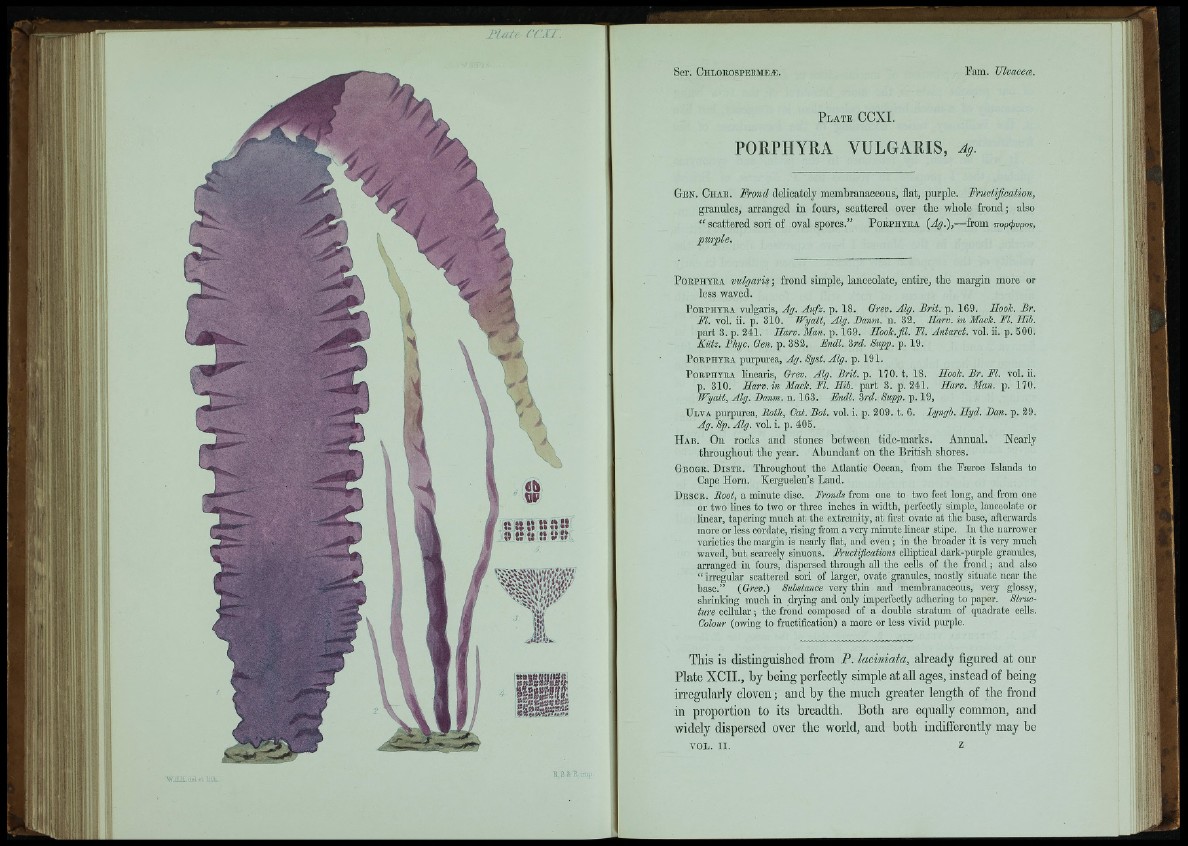
p i h J î m / .
!'è i
1 1
P l a t e CCXI.
PORPHYRA VULGARIS, Jy .
G e n . C iia e . Frond deKoately m embranaceous, flat, p u rp le .
g ran u le s, a rra n g e d in fo u rs, s c a tte re d over th e whole f r o n d ; also
“ s c a tte re d so ri of oval spores.” P o e p h y e a {Ag.),—from mptjivpos,
P o e ph y ea vulgaris; frond simple, lanceolate, entire, the margin more or
less waved.
PoKPiiYKA vulgaris, Ag. A u fi. p. 18. Grev. Alg. Brit. p. 169. Hook. Br.
M. vol. ii. p. 310. Wyatt, Alg. Banm. n. 32. Ilarv. in Mack. Fl. Hib.
part 3. p. 241. Harv. Man. p. 169. Hook.fil. M. Antarct. vol. ii. p. 500.
Kiitz. Phyc. Gen. p. 382. Endl. 3rd. Supp. p. 19.
P oeph y ea purpurea, Ag. Syst. Alg. p. 191.
P oephyea linearis, Grev. Alg. Brit. p. 170. t. 18. Hook. Br. El. vol. ii.
p. 310. Harv. in Mack. El. Hih. part 3. p. 241. Harv. Man. p. 170.
Wyatt, Alg. Banm. n. 163. Endl. 3rd. Supp. p. 19,
U lva purpurea. Both, Cat. Bot. vol. i. p. 309. t. 6. Lyngh. Hyd. Ban. p. 39.
Ag. Sp. Alg. vol. i. p. 405.
H ab. On rocks and stones between tide-marks. Annual. Nearly
throughout the year. Abundant on the British shores.
Geoge. D is t e . Tkrougliout the Atlantic Ocean, from the Færoe Islands to
Cape Horn. Kerguelen’s Land.
D e sc e . Boot, a minute disc. Fronds from one to two feet long, and from one
or two lines to two or three inches in width, perfectly simple, lanceolate or
linear, tapering much at the extremity, at first ovate at the base, afterwards
more or less cordate, rising from a very minute linear stipe. In the narrower
varieties the margin is nearly flat, and even ; in the broader it is very much
waved, but scarcely sinuous. Fructifications elliptical dark-purple granules,
arranged in fours, dispersed through aU the cells of the frond ; and also
“ irregular scattered sori of larger, ovate granules, mostly situate near the
base.” (Grev.) Substance very thin and membranaceous, very glossy,
sluinking much in drying and only imperfectly adhering to paper. Structure
cellular ; the frond composed of a double stratum of quadrate cells.
Colour (owing to fructification) a more or less vivid purple.
This is distinguished from P. laciniata, already figured at our
Plate XCII., hy being perfectly simple at all ages, instead of being
irregularly cloven ; and by the much greater length of the frond
in proportion to its breadth. Both are equally common, and
widely dispersed over the world, and both indifferently may be
VOL. I I . z
'[■n